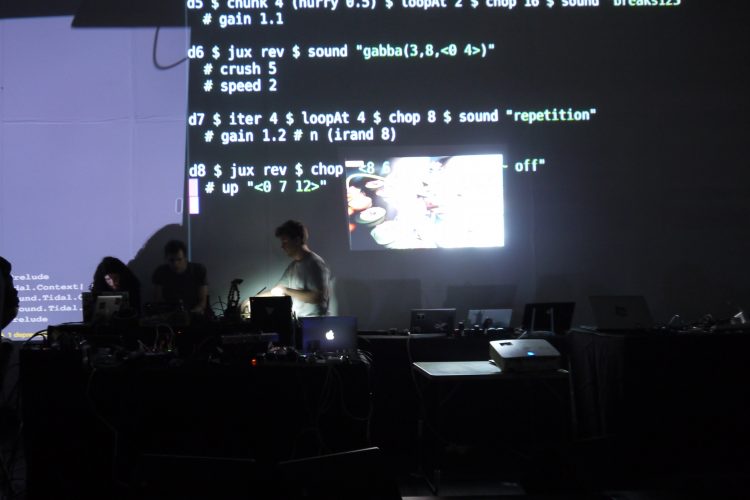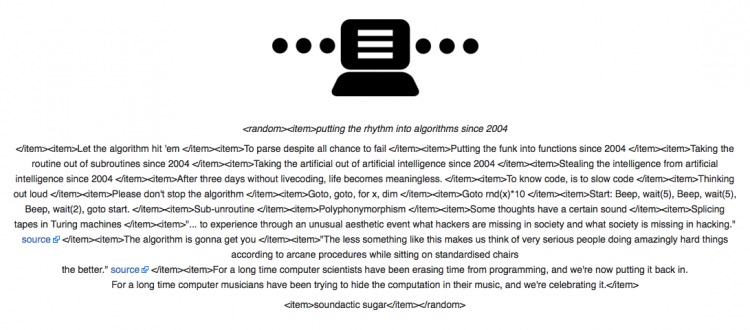And Sheffield invented the algorave…
Published 28 November 2017 by Elsa Ferreira
For more than a decade, the algorave scene has made ravers dance to computer code. Makery went to investigate where it all began, in Sheffield, which hosted the Algomech festival in early November.
Sheffield, special report
Some epicenters are less likely than others; Sheffield is one of them. This city with a population of 560,000 in Northern England is known for Warp label’s avant-gardist techno and broken beat, as well as the experimental new wave of Cabaret Voltaire and Human League. More recently, musician Alex McLean has put it back on the alternative music map with algorave, a contraction of algorithm and rave, referring to the scene of artists who live code their music performances.

We first met Alex McLean as his alias Yaxu, surrounded by other techno musicians at the Unconscious Festival in London. But for the Algomech (algorithm + mechanics) festival, which he organized on November 8-12 in Sheffield, McLean brought together the big names of the algorave scene—especially the local ones, “so as not to increase our carbon footprint with international flights,” he says (half) joking.
On stage, Goto80, aka Anders Carlsson, Swedish musician and one of the first artists to explore chiptunes, or 8-bit music, stands behind his Commodore 64, the best-selling home computer from 1982 and one of the most popular of this first generation. He faces a robotic arm that is also playing a keyboard, created by Jacob Remin, an artist based in Copenhagen. Their set is followed by T.Y.P.E, a trio that weaves and unweaves code in a sort of battle of the programmers; Slub, a trio that includes Alex McLean; Joanne Armitage, a pioneer of live coding; and Tich, a regular on the rave scene and director of the label Off Me Nut, who came to try her hand at live coding for the first time. On visuals, Antonio Roberts, aka Hellocatfood, a new media artist from Birmingham.
A few days earlier, to open the 65daysofstatic festival, McLean welcomed an experimental group originally from Sheffield, who—after composing the soundtrack to No Man’s Sky, a virtually endless generative video game (it would take a single player “500 billion years” to explore the entire game)—presented their new project Decomposition Theory, a performance created from music generated in real-time by a series of algorithms.
“Decomposition Theory”, 65daysofstatic, trailer for Algomech festival (2017):
“Rhythm into algorithms”
The algorave scene existed before its name. It emerged in the early 2000s from groups dedicated to the open music software SuperCollider. In February 2004, the community first took form as Toplap, “an organization to explore and promote live coding”. A handful of people met in “a smoky bar in Hamburg” and wrote the first manifesto of the algorave movement, which resembles a haiku for developers. The movement’s philosophy? “Serious fun,” replies McLean. “All this is a joke, but we put in a lot of effort.”

Algoravers are curious people. Not content to simply live code their music, they choose alternative events to give their concerts. Like the Placard Headphone festivals, which originated in Paris in 1997, long before silent disco and other Boiler Rooms, where participants listened through headphones to live sets on the Internet for the duration of the festival, from a few hours to 97 days nonstop. “I like small-scale events,” says McLean. “Events that are different, experiments that might not even work. With Placard Headphone, the idea was to make music without a venue to host it. The room is your apartment. We tried to create an experimental scene that otherwise wouldn’t exist.”
The name algorave came later, in 2012. It was then that McLean registered the website algorave.com, indexing all the algoraves worldwide. The movement expanded, like the BYOB events for visual artists, or Dorkbot, events for “people who do stange things with electricity” born in New York and exported all over the world, including London, thanks to McLean’s tireless initiative. “Events such as TedX and Maker Faire are very protected,” he says. “To organize them, you really need to follow the rules. With algorave, anyone is free to do whatever they want, you don’t have to sign anything, you can use the visuals, the name.” At most, he provides consulting on how to make the program inclusive. “If you don’t start right away, it’s hard to catch up later,” he warns.
Open source music
In detail, live coding is like a knitting pattern, McLean explains. “We work with loops, structures that repeat.” He himself developed an open source programming environment, TidalCycles, used primarily by the algorave community. “If you work on a sequencer, you change the sound of each note, for example. With live coding, you work on a higher level, because you’re more interested in the structure behind these notes. You don’t work on individual notes but on lots of notes at the same time and the way they’re connected together.” In the background, SuperCollider, an open source platform for audio synthesis and algorithmic composition, generates sounds from commands sent by Tidal.
Demo of Tidal by Yaxu for the launch of his album “Peak Cut” (2015):
Other live coding environments were developed by members of the algorave scene, such as Troop, developed by Ryan Kirkbride of the trio T.Y.P.E, which lets members interact with each other’s codes like a shared Google Doc, the trio explains. The open source software is available on GitHub.
“Everything is based on the idea of transparency and sharing,” says McLean. During performances, the code is projected on the walls. When artists upload their pieces online, they use a format that lets them distribute the code in addition to the recording. So when Yaxu released Peak Cut in 2015, he put it on a USB stick. Currently, he’s preparing an album to be released on Raspberry Pi.
Goto80 shares this perspective, as he sees music “as data” rather than as “a static recording”. His latest album, Floptrik, was released on… floppy disk (of the Commodore generation). “It’s interesting to see that so many different kinds of music are made on a computer but are always released as boring recordings,” says the artist. “So much information is lost in the process. Open source music reveals more information on how the composer composed the piece, how the instruments were made, etc.” He also releases most of his music in open source formats. “It’s important, at least from a future archaeological perspective. An interesting bonus is that it’s easier to feed my music to neural networks to teach the machine how I do things.” A path that the musician is actively exploring…
“Fist of Trade”, Floptrik, by Goto80 (2017):
From software to hardware
At the Algomech festival, which attracted several hundred fans, McLean bridges the gap between pixels and physics. This year, a symposium on “unmaking” as a form of resistance followed conferences on maker culture from the first edition. Sunday was dedicated to workshops to make a mini battery or a musical e-textile.
A post shared by Leafcutter John (@leafcutterjohn) on
The festival closed with a tribute to crazy and poetic fabrications by musician makers. Ravers could sit and admire the infernal machine of Sarah Kenchington and her mechanical orchestra, the fruit of ten years of labor and collecting strange instruments, a machine that blows into accordions by Camilla Barratt-Due and Alexandra Cardenas, or a machine that reads 3D printed records based on the relief of geographical zones from Yorkshire to Nevada by John Burton, aka Leafcutter John. Or quite simply, music explored in its many forms.
More info on Algomech 2017
